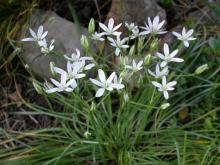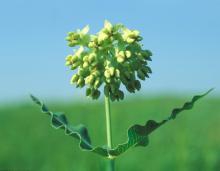Wildflowers, Grasses and Other Nonwoody Plants
Media

Species Types
Scientific Name
Lippia lanceolata (formerly Phyla lanceolata)
Description
Common in almost any kind of moist, wet or muddy habitat, fog fruit bears interesting round, purple flower heads that are ringed by small, white or pinkish flowers.
Media

Species Types
Scientific Name
Ornithogalum umbellatum
Description
Star of Bethlehem is an introduced exotic plant that makes clusters of bright white flowers in the spring. It reproduces prolifically by forming a multitude of bulbs underground.
Media

Species Types
Scientific Name
Cardamine concatenata (formerly Dentaria laciniata)
Description
Toothwort is a member of the mustard family that blooms March–May in wooded slopes and valleys. The sharply toothed, deeply lobed leaves are distinctive. The bright white, 4-petaled flowers shine at forest visitors.
Media

Species Types
Scientific Name
Micranthes virginiensis (syn. Saxifraga virginiensis)
Description
In Missouri, early saxifrage blooms February through June on rock outcroppings, ledges, glades, and bluffs. The flowers are at the tops of leafless stems. The fleshy, ovate leaves are in a basal rosette.
Media

Species Types
Scientific Name
Desmodium spp. (17 species in Missouri)
Description
Missouri has 17 species of tick trefoils, which live in a variety of habitats. Hikers know them well from their chains of hairy little seedpods that stick to clothing like parasites!
Media

Species Types
Scientific Name
Oenothera filiformis (formerly Gaura longiflora, G. biennis)
Description
Large-flowered gaura is a tall plant whose white flowers turn pinkish as they age. Four petals point upward, then bend back, and 8 stamens droop downward. The flowers look something like small butterflies.
Media

Species Types
Scientific Name
Dalea purpurea (formerly Petalostemon purpureum)
Description
Purple prairie clover is a legume of prairies, glades, and other open places. Its unusual flowering heads ringed with rose-magenta flowers and its attractive foliage add special interest in the home garden.
Media

Species Types
Scientific Name
Mimosa quadrivalvis (also Schrankia nuttallii)
Description
Sensitive briar is a dainty-looking legume with delicate, twice-compound leaves and flower heads resembling magenta pom-poms. The long, tough stems are covered with tiny thorns that snag your feet as you walk.
Media

Species Types
Scientific Name
Asclepias meadii
Description
Mead's milkweed, an endangered wildflower, once flourished in the tallgrass prairies of the midwestern United States, including most of Missouri.
Media

Species Types
Scientific Name
Penstemon digitalis
Description
Foxglove, or smooth beardtongue is a showy flower that is popular in native gardening. It is the tallest of the four white-flowered penstemons in Missouri.
See Also
About Wildflowers, Grasses and Other Nonwoody Plants in Missouri
A very simple way of thinking about the green world is to divide the vascular plants into two groups: woody and nonwoody (or herbaceous). But this is an artificial division; many plant families include some species that are woody and some that are not. The diversity of nonwoody vascular plants is staggering! Think of all the ferns, grasses, sedges, lilies, peas, sunflowers, nightshades, milkweeds, mustards, mints, and mallows — weeds and wildflowers — and many more!





















